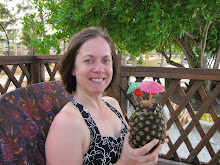 |
| Rene and Tracy in Bali |
Bali is probably the best known of the 17,500 islands in the Indonesian archipelago to Westerners. Bali is known for its beautiful beaches, wonderful climate, friendly people AND to fiber people for its lovely textiles. Rene Derewetzky (Tall Pines guild member) has been living in Jakarta for the last 3 ½ years, during that time she has accumulated both a lovely collection and knowledge of Indonesian textiles. Unfortunately for me Rene and her family are being repatriated back to Houston in December. As a last hurrah Rene offered to go with me to Bali and take me around to see Balinese textiles. I jumped at the offer and met Rene in late October in Bali. It was lovely to go on a trip where you just show up and everything is arranged.
From the airport we went straight to a nearby shop in Denpassar that had Balinese batik yardage in cotton and rayon for $2.00 a meter! Balinese batik is very tropical, bright colors, large motifs, not nearly as intricate as other Indonesian batiks, but fun stuff! Upstairs they had a nice collection of older Javanese textiles, mostly large pieces (Hinggi) that were warp ikat and supplementary weft. It was a great way to start the trip.
 |
| Wall of brightly colored cotton batik |
Our first night we stayed in Kuta and enjoyed a lovely fresh fish dinner on the beach. Kuta is where tourism in Bali got started, there is a lot of traffic, lots of shops with touristy stuff for sale, it is where the younger tourists looking for night life stay.
The next morning we headed toward Ubud. Ubud is a town where a lot of artisans have settled, it too has a large tourism industry but it still maintains a more low keyed feeling, like I expect Bali was years ago. Our first stop in Ubud was at Threads of Life Indonesian Textile Center. WOW, what a neat place. From their brochure: “Threads of Life commissions textile weavers, basket makers and other traditional artists across Indonesia to recover the skills of their ancestors, working to an exquisite standard usually only seen in museums. Since 1998 we have sponsored the weaving of traditional, handmade, natural-dyed textiles, baskets and crafts that often take years to complete. We work directly with the artists, helping them establish cooperatives that build their financial security.” The shop is small but it is packed with beautiful work for sale and displays demonstrating the different techniques used to create the textiles. When you buy a piece you receive a photo of the artisan who made the piece and a DVD with a PowerPoint slide show of that area’s people and their work. It was wonderful to see how much Threads of Life is doing to educate people about the wonderful textiles of Indonesia.
 |
| Threads of Life, display of tied warps for ikat. Notice the naturally dyed skeins hanging in the background. |
 |
| Selection of finished double-ikat (geringsing). I purchased one of the smaller pieces. The colors are traditional and are all naturally dyed. |
 |
| Winding the weft for double-ikat |
 |
| Indigo pots, aren't they lovely. Notice skeined yarn hanging from the rafters. |
 |
| Wayan's mother demonstrating spinning their homegrown cotton. Interesting wheel. |
On returning to Ubud we finished up our trip with one more visit to Threads of Life, thanking them for their excellent recommendations on places to visit and purchasing a few more pieces for our collections. Next time I’ll add the village where they produce Songket (supplementary weft with metallic thread) to my itinerary!



